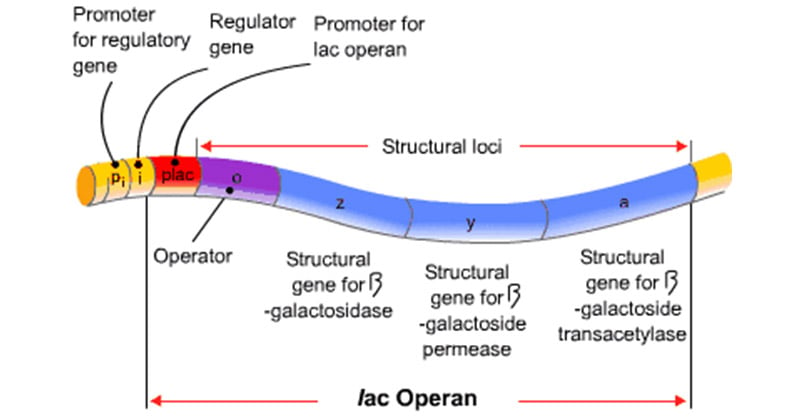- Regulation of protein synthesis is necessary in all cells.
- Particularly, in the prokaryotic cells, regulation is achieved by means of genetic units called operons alongside a number of related mechanisms as described below:
-
Regulation of Protein Synthesis on the Basis of Nutrient Supply
- Prokaryotes respond to changes in their supply of nutrients in a way that allows them to obtain or conserve energy most efficiently.
For Example.
- E. coli uses glucose preferentially whenever it is available. The enzymes in the pathways for glucose utilization are made constitutively i.e., they are constantly being produced.
- However, if glucose is not present in the medium but another sugar is available, E. coli produces the enzymes and other proteins that allow the cell to derive energy from that sugar.

-
Regulation by means of Operons
- Regulation of protein synthesis in prokaryotes occurs mainly at the transcriptional level, and involves genetic units known as operons.
- An operon is a set of genes that are adjacent to one another in the genome and are coordinately controlled; that is, the genes are either all turned on or all turned off.
- Operons contain promoter regions where proteins bind and facilitate or inhibit the binding of RNA polymerase.
- When RNA polymerase transcribes the structural genes of an operon, a polycistronic mRNA (i.e., an mRNA that codes for more than one polypeptide) is produced.
Interesting Science Videos
2.1. Regulation by Induction
- Induction is the process whereby an inducer (a small molecule) stimulates the transcription of an operon.
- The inducer is frequently a sugar (or a metabolite of the sugar), and the proteins produced from the inducible operon allow the sugar to be metabolized.
Working of an Inducer:
(1) The inducer binds to the repressor, inactivating it.
(2) The inactive repressor does not bind to the operator.
(3) RNA polymerase, therefore, can bind to the promoter and transcribe the operon.
(4) The structural proteins encoded by the operon are produced.
Example:
If glucose is not present in the provided medium but another sugar is available, E. coli produces the enzymes and other proteins that allow the cell to derive energy from that sugar.
The process by which the synthesis of the enzymes is regulated is called induction.
The Lac operon is inducible.
2.2. Regulation by Repression
- Repression is the process whereby a corepressor (a small molecule) inhibits the transcription of an operon.
- The co-repressor is usually an amino acid, and the proteins produced from the repressible operon are involved in the synthesis of the amino acid.
Working of a Repressor
(1) The corepressor binds to the repressor, activating it.
(2) The active repressor binds to the operator.
(3) RNA polymerase, therefore, cannot bind to the promoter, and the operon is not transcribed.
(4) The cell stops producing the structural proteins encoded by the operon.
For Example:
If an amino acid is present in the medium, E. coli does not need to synthesize that amino acid and conserves energy by ceasing to produce the enzymes required for its synthesis. The process by which the synthesis of these enzymes is regulated is called repression.
The Tryptophan operon is repressible.
-
Regulation by Positive Control
- Some operons are turned on by mechanisms that activate transcription.
- When the repressor of the arabinose (ara) operon binds arabinose, it changes the conformation and becomes an activator that stimulates the binding of RNA polymerase to the promoter.
- The operon is then transcribed, and the proteins required for the oxidation of arabinose are produced.
-
Regulation by Catabolite Repression
Some operons (e.g., lac and ara) are not expressed when glucose is present in the medium. These operons require cAMP for their expression.
Working:
(1) Glucose causes cAMP levels in the cells to decrease.
(2) When glucose decreases, cAMP levels rise.
(3) cAMP binds to the catabolite-activator protein (CAP).
(4) The cAMP–protein complex binds to a site near the promoter of the operon and facilitates
binding of RNA polymerase to the promoter.
Example:
The lac operon exhibits catabolite repression.In the presence of lactose and the absence of glucose, the lac repressor is inactivated, and the high levels of cAMP facilitate the binding of RNA polymerase to the promoter. The operon is transcribed, and the proteins that allow the cells to utilize lactose are produced.
-
Regulation by Attenuation
- In bacterial cells, transcription and translation occur simultaneously.
- Attenuation occurs by a mechanism by which rapid translation of the nascent transcript causes the termination of transcription.
- As the transcript is being produced, if ribosomes attach and rapidly translate the transcript, a secondary structure is generated in the mRNA that is a termination signal for RNA polymerase.
- If translation is slow, this termination structure does not form, and transcription continues.
Example:
The trp operon, as well as other amino acid biosynthetic operons, is regulated by attenuation.
References
- Smith, C. M., Marks, A. D., Lieberman, M. A., Marks, D. B., & Marks, D. B. (2005). Marks’ basic medical biochemistry: A clinical approach. Philadelphia: Lippincott Williams & Wilkins.
- David Hames and Nigel Hooper (2005). Biochemistry and Genetics. Third ed. Taylor & Francis Group: New York.
- Sastry A.S. & Bhat S.K. (2016). Essentials of Medical Microbiology. New Delhi: Jaypee Brothers Medical Publishers.
- https://www.ncbi.nlm.nih.gov/pmc/articles/PMC196965/

Very explicit and elaborate and self explained notes which is very helpful for teaching and learning processes.